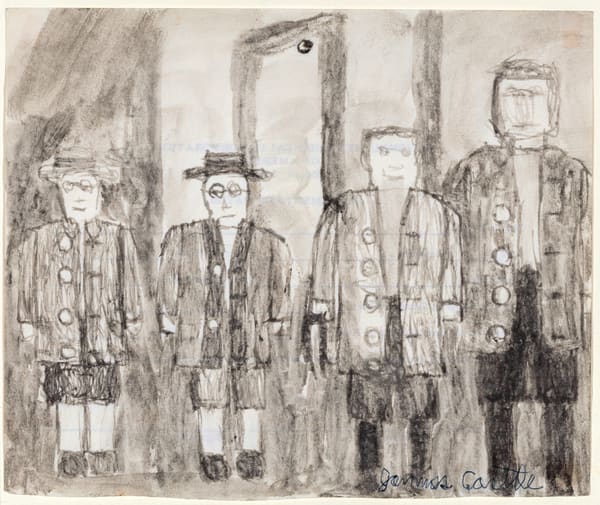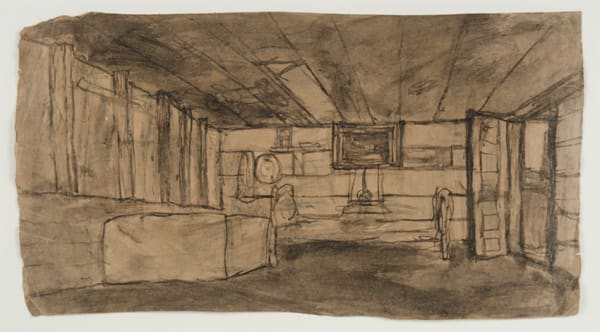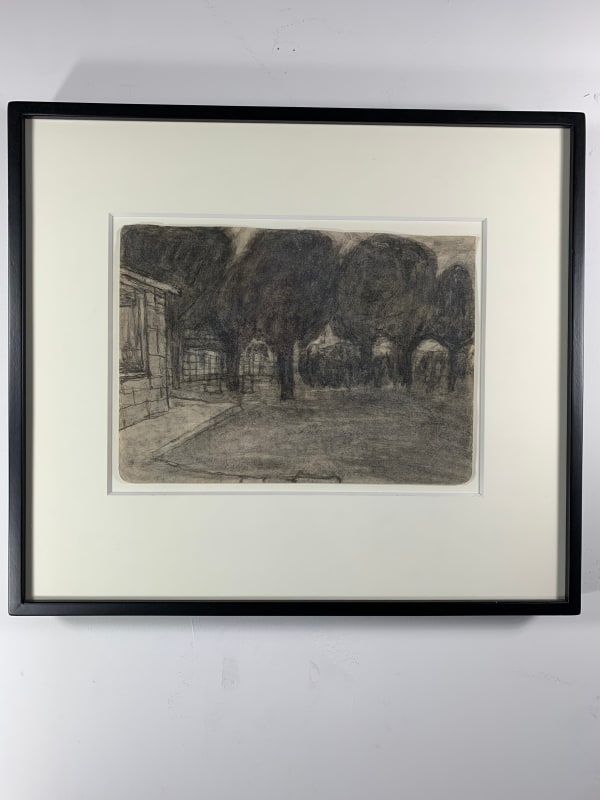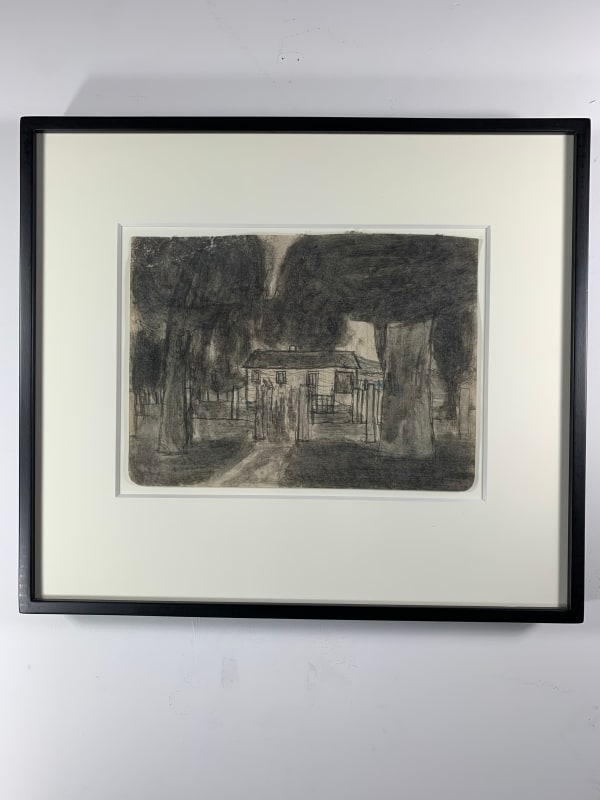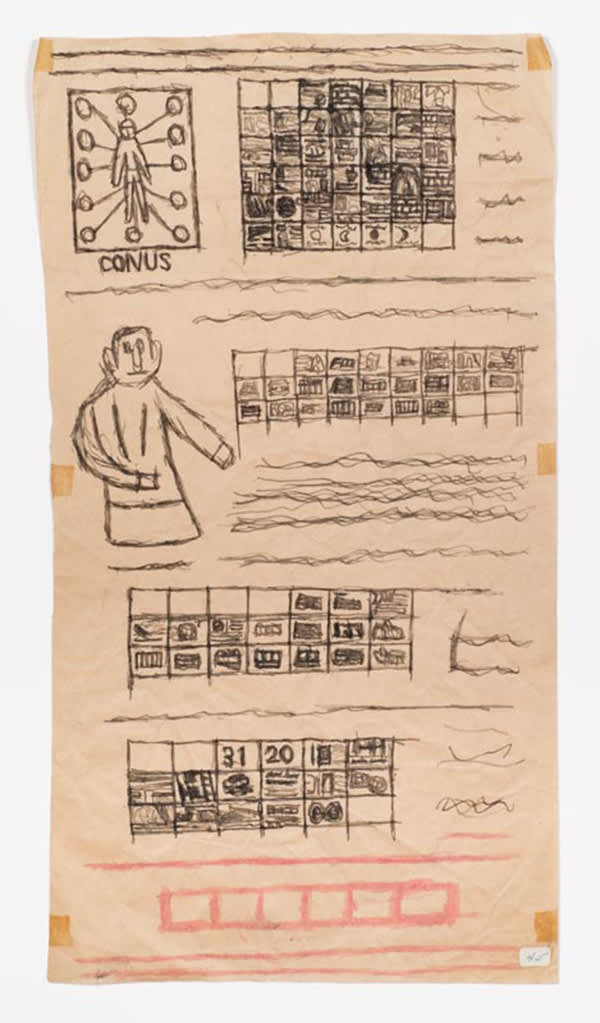James Castle American, 1899-1977
James Castle was born prematurely, and profoundly deaf, in the mountainous town of Garden Valley, Idaho. His mother was a midwife and his father a postmaster who ran the local post office and general store from the family’s home. Perhaps owing to his disability, Castle, the fifth of seven children, did not attend school before the age of ten, but spent most of his time at home, drawing and crafting objects from a very young age. He attended the Idaho School for the Deaf and Blind in Gooding from 1910 to 1915, where he was taught an oral method of communication involving lip reading and voice training, though it is unclear to what extent he could read or write.
Castle devoted his long, secluded life to creating an immense opus that comprises drawings, paintings, assemblages, sculptural objects, text pieces, and artist’s books. Although he knew little about the world beyond his narrowly circumscribed community and nothing about art history, today his work is regarded as parallel to vanguard art of the twentieth century. Castle worked entirely with found materials; his daily rummage of trash cans provided an abundant supply of discarded paper, printed media, and empty containers. He used soot that he gathered from a wood-burning stove and mixed with his own saliva as his main pigment, which he applied with matchsticks, fountain pen tips, and even apricot pits rather than brushes. He took endless inspiration from every corner of his quiet existence, sensitively rendering landscapes, buildings, interiors, animals, and people. A mix of impressionism, realism, and abstracted figuration marks his signature style of rendering with smudged atmospheric textures, architectural lines and patterns, and schematic totemic figures in imagery that is at once serene and imbued with a profound sense of mystery.
As an obsessive chronicler, Castle was captivated by the written word—surely for its graphic qualities, but likely also because its denotation remained inscrutable to him in a way that images were not. In illustrating seemingly every aspect of his immediate surroundings and reality, even those he could not fully grasp, Castle opened many windows into his mind and into his evolution as an artist. In her essay on Castle in the book The Hidden Art, Lynne Cooke described Castle’s method: “From his memories and the trove of printed material he amassed, he created a recursive relationship between his real and imaginary worlds that not only sustained his work over decades, but became the basis for a sophisticated understanding of the concept of artistic identity and the practice of artmaking.”
In the 1950s Castle’s work was introduced to the art world through the efforts of his nephew Bob Beach. Castle’s first solo museum exhibition was held in 1963 at the Boise Art Museum (which today has the largest collection of works by the artist in any museum) and his work has continued to be extensively exhibited. In 2008, the Philadelphia Museum of Art mounted James Castle: A Retrospective, which toured nationally. In 2011 the Museo Nacional Centro de Arte Reina Sofía in Madrid organized a major exhibition of Castle’s work titled Mostrar y almacenar (Show and Store). In 2013 his work was included in the Venice Biennale’s centerpiece exhibition The Encyclopedic Palace, and in 2017 the Whitney Museum of American Art in New York included Castle in the exhibition Where We Are. Most recently, in 2018, his work was featured in Outliers and American Vanguard Art, a traveling exhibition organized by the National Gallery of Art in -Washington, D.C. Castle’s work is in the -collections of the Museum of Modern Art in New York, the Whitney Museum of American Art, the New York Public Library, the American Folk Art Museum (New York), the Berkeley Art Museum, the Boise Art Museum, Intuit: The Center for Intuitive and Outsider Art, the Art Institute of Chicago, the High Museum of Art (Atlanta), the Philadelphia Museum of Art, the Tacoma Art Museum, and the Milwaukee Art Museum.
-
 Untitled (Three Figures in Front of Window), nd
Untitled (Three Figures in Front of Window), nd -
 Untitled (Boxing Match), c. 1955-65
Untitled (Boxing Match), c. 1955-65 -
 (Untitled) Dream House With Tree
(Untitled) Dream House With Tree -
 Barn Interior and Landscape (2-sided drawing)
Barn Interior and Landscape (2-sided drawing) -
 Castle Family
Castle Family -
 Couple on Street & Backyard View (2-sided drawing)
Couple on Street & Backyard View (2-sided drawing) -
 Farm House and Silos (2-sided drawing)
Farm House and Silos (2-sided drawing) -
 Group of 5 (2)
Group of 5 (2) -
 Group of 5 (3)
Group of 5 (3) -
 Group of 5 (4)
Group of 5 (4) -
 Group of 5 (5)
Group of 5 (5) -
 Group of 5 of James Castle's interior of house at Boise (1)
Group of 5 of James Castle's interior of house at Boise (1) -
 Interior Views (2 sided drawing)
Interior Views (2 sided drawing) -
 Untitled ("Wings" Book,Gooding School interior drawings)
Untitled ("Wings" Book,Gooding School interior drawings) -
 Untitled (Bird With Big Tail)
Untitled (Bird With Big Tail) -
 Untitled (Books Displayed Along a Wall)
Untitled (Books Displayed Along a Wall) -
 Untitled (Camel Book)
Untitled (Camel Book) -
 Untitled (Coat)
Untitled (Coat) -
 Untitled (Colored Abstraction)
Untitled (Colored Abstraction) -
 Untitled (Double-sided farmscapes)
Untitled (Double-sided farmscapes) -
 Untitled (Double-sided painting with fence)
Untitled (Double-sided painting with fence) -
 Untitled (Figure in tan coat)
Untitled (Figure in tan coat) -
 Untitled (Friends)
Untitled (Friends) -
 Untitled (interior with open door)
Untitled (interior with open door) -
 Untitled (Landscape panorama) ( 11 of 12)
Untitled (Landscape panorama) ( 11 of 12) -
 Untitled (Landscape Panorama) ( 12 of 12)
Untitled (Landscape Panorama) ( 12 of 12) -
 Untitled (Landscape panorama) (1 of 12)
Untitled (Landscape panorama) (1 of 12) -
 Untitled (Landscape panorama) (10 of 12)
Untitled (Landscape panorama) (10 of 12) -
 Untitled (Landscape panorama) (2 of 12)
Untitled (Landscape panorama) (2 of 12) -
 Untitled (Landscape panorama) (3 of 12)
Untitled (Landscape panorama) (3 of 12) -
 Untitled (Landscape panorama) (4 of 12)
Untitled (Landscape panorama) (4 of 12) -
 Untitled (Landscape panorama) (5 of 12)
Untitled (Landscape panorama) (5 of 12) -
 Untitled (Landscape panorama) (6 of 12)
Untitled (Landscape panorama) (6 of 12) -
 Untitled (Landscape panorama) (7 of 12)
Untitled (Landscape panorama) (7 of 12) -
 Untitled (Landscape panorama) (8 of 12)
Untitled (Landscape panorama) (8 of 12) -
 Untitled (Landscape panorama) (9 of 12)
Untitled (Landscape panorama) (9 of 12) -
 Untitled (landscape with building and figures)
Untitled (landscape with building and figures) -
 Untitled (Landscape with farm buildings on envelope)
Untitled (Landscape with farm buildings on envelope) -
 Untitled (Landscape)
Untitled (Landscape) -
 Untitled (Santa Claus visits children)
Untitled (Santa Claus visits children) -
 Untitled (shed and fence)
Untitled (shed and fence) -
 Untitled (Shed)
Untitled (Shed) -
 Untitled (text and symbols with pink bottom)
Untitled (text and symbols with pink bottom) -
 Untitled (Three Figures On Geometric Background)
Untitled (Three Figures On Geometric Background) -
 Untitled Block Patterns (2 sided drawing)
Untitled Block Patterns (2 sided drawing) -
 Untitled Patterned Landscape
Untitled Patterned Landscape





